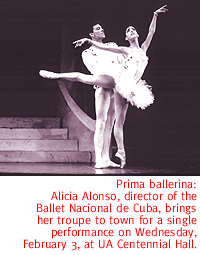
Last Weekend's Festival And This Week's 'Giselle' Showcase Top-Notch Dance Talent.
By Margaret Regan
ALICIA ALONSO MAY well be the last living representative
of classical Russian badiences this week have a chance to see
her version of dance untainted by modernism. On Wednesday, the
Ballet Nacional de Cuba, the company Alonso founded back in 1948,
brings her sumptuous production of Giselle to Centennial
Hall.
 The romantic 19th-century ballet that Alonso herself danced more
than any other, Giselle is a strange story of a fragile
young peasant woman trifled with by a prince. In her grief, she
dances herself to death, and joins the otherworldly Wilis, prospective
brides who never had a chance to wed. Yet Giselle still protects
her prince even after death.
The romantic 19th-century ballet that Alonso herself danced more
than any other, Giselle is a strange story of a fragile
young peasant woman trifled with by a prince. In her grief, she
dances herself to death, and joins the otherworldly Wilis, prospective
brides who never had a chance to wed. Yet Giselle still protects
her prince even after death.
Alonso's own illustrious dancing career was shaped in part by
politics. A prima ballerina in New York in the '40s and '50s,
Alonso danced with American Ballet Theater and American Ballet
Caravan. She worked with choreographic luminaries from Balanchine
to de Mille. But after the Cuban Revolution in 1959, Alonso worked
mostly in her native country. She and her Cuban dancers were not
entirely isolated, however: They enjoyed frequent fruitful exchanges
with the Soviet Union's Kirov and Bolshoi ballets, devotees both
of the classical tradition Alonso herself was the first Westerner
to dance in the USSR.
Now 77, Alonso no longer performs, but she's launched her company
on its first major U.S. tour in 20 years. Her Giselle is
unabashedly traditional, a hearkening back to the Russian school.
In a 1979 interview, she told writer Barbara Newman, "In
our company...we try definitely to understand the Romantic style,
definitely to understand in what time was that ballet done...(Giselle)
is very special. I think it captures the essence of Romanticism
in a very beautiful way."
TUCSON'S OWN EVA Tessler was the hit of the show at the
Fifth Annual Arizona Contemporary Dance Festival at the
PCC Center for the Arts last weekend.
Performing in a line-up of 10 modern dance companies from around
the state, Tessler and the Zenith Dance Collective were a standout
in her powerful elegy "The Shining Path: To Daniel Forever."
Six dancers, Tessler included, danced a series of athletic movements
on the theme of coming together and breaking apart. The work was
shaded by some political overtones about group resistance, but
it was also a kind of widow's dance, dedicated to Tessler's late
husband, Daniel Nugent, a UA anthropology prof and playwright
who died at age 43 in 1997.
"The Shining Path" was everything modern dance can
be: profound, emotional, but commendably stark in its aesthetics.
The concert, which annually gathers a coalition of loosely defined
"professional" modern dance troupes based in Arizona,
also showcased modern dance at its worst. Inspired by some truly
bad work, my companion proposed an excellent new rule for start-up
modern dance troupes: submit to a total ban on New Age music.
 The combination of insipid New Agey rhythms and inept dance
is about impossible to take, as Opendance so ably demonstrated.
Likewise, Flagstaff's Canyon Movement Company did a tedious work
alluding to the distant past. "Gathers & Cast Away"
was full of rocks and serious faces and music of hypnotic boredom.
The combination of insipid New Agey rhythms and inept dance
is about impossible to take, as Opendance so ably demonstrated.
Likewise, Flagstaff's Canyon Movement Company did a tedious work
alluding to the distant past. "Gathers & Cast Away"
was full of rocks and serious faces and music of hypnotic boredom.
Tucson's own modern dance troupes have long since accustomed
their audiences to far more intelligent work. Annie Bunker and
Charles Thompson of Orts Theatre of Dance reprised Bunker's "Ave
Maria," a spare trapeze piece whose spirituality turns erotic.
Thom Lewis of Tenth Street Danceworks performed his familiar "Dreaming
Under Fire," a powerful solo that merges "The myth of
Prometheus and the American tragedy of Vietnam," as a program
note explains.
Frances Smith Cohen's Center Dance Ensemble, a much-respected
Phoenix group, performed her superb "A Time for Silence,
A Time to Be Together." Cohen nimbly moved 13 dancers through
complicated groupings. The only music in the first half was the
body rhythms generated by the dancers slapping their legs. Desert
Dance Theatre, also up in the Valley of the Sun, did the amusing
"Ritmica Caliente" about a lonely guy's fantasies at
a swing dance ballroom. A Ludwig Dance Theater performed a series
of tantalizing--if too short--excerpts from Ludgwig's full-length
work on marriage, "Til Death Do Us Part." The parading
brides at the beginning were a hoot.
The moral of the concert, as it has been from the festival's
inception five years ago, is this: Organizer Chuck Fischl of Southwest
Dance should expel the worst of the troupes through some form
of competitive audition. It would be a far, far better thing to
have a concert of only the best companies. I'd rather see Tessler
or Bunker or Cohen's troupe perform twice, or even thrice, than
be subjected to a single additional offering of ancient mania.
Ballet Nacional de Cuba performs Giselle at 8 p.m.
Wednesday, February 3, at UA Centennial Hall. (Note: This
marks a change from the originally scheduled performance of Saturday,
February 6). UA dance professor Melissa Lowe hosts a free pre-concert
talk at 7:15 p.m. in Room 102 of the Center for English as a Second
Language, at 1100 E. N. Campus Drive, north of Centennial Hall.
Tickets range from $13 to $38. For more information call 621-3341.

|





